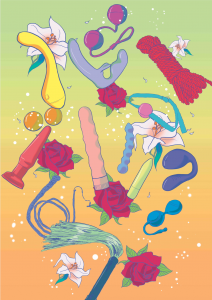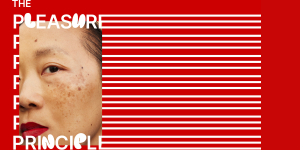Sex toys, gender and jerking off in sexually ‘liberated’ America
By: Hal Olson

I don’t know precisely when Walgreens of New Paltz, New York started selling sex toys.
I only go there every three months or so, when I need to replenish my supply of Flossers with Gum Stimulator (Mint Flavour).
At some point recently, they either started selling sex toys, or underwent a store reorganisation that moved the sex toys closer to the oral hygiene products. Thus, I was buying floss and my virgin eyes spotted one kegel trainer, one vibrating wand, one “rhythmic multi-vibe” dildo, one butt plug and a hot pink “fluttering arouser”.
These adult novelties were novel to me. But as it turns out, sex toys have been making their way onto US drug store shelves since the mid-2000s, however haltingly.
Although the Tucker Carlsons and Marjorie Taylor Greenes of the world said that they were appalled to ‘suddenly’ find sex toys in Target and CVS in 2022, there have been adult novelties for sale in at least some chain pharmacies since 2005 at the latest.
Nonetheless: I am accustomed to butt plugs being relegated to stores that are overlit and sticky.
There aren’t a lot of sex toys at my usual Walgreens.
It’s not a Spencer’s, with its wall of dildos to amuse mall-wandering teens. It’s also not a full-on sex shop, with aisles of products adorned with fleshy directness – featuring photographs of the toy being used around/on/in someone’s oiled-up parts. (In the US, the sex toy industry is almost entirely unregulated, for better or for worse.)
At least, this Walgreens isn’t like the one Spencer’s that I’ve visited, nor is it like the two sex shops I’ve perused (I went to these stores for academic reasons [I’m a virgin]).
At Walgreens, the sex toys are tucked away in a back corner. They’re in trendy and tasteful packaging, with small sans serif fonts. The toys are depicted in silhouettes of swirling colour, so that they look like sexy lava lamps.
I’m a straight, cisgender man, mostly.
The sex toys are not in a section I normally venture into; they’re right above the lube, but separate from the condoms, which are a few aisles away.
That section with the condoms and ‘male’ virility enhancers is called ‘Family Planning’, while the toys and lube are in a section called ‘Sexual Wellness’. From the names, one might think that Family Planning is for contraception, while Sexual Wellness is for pleasure.
The real organisational logic, though, is far more crude: Sexual Wellness seems to be a ‘girl section’, while Family Planning is a ‘boy section’; the cis-ness of it all is baked into the marketing.
Sexual Wellness is right next to the pads and tampons. It contains tasteful sex toys, pregnancy tests and vaginal contraceptive film.
In Family Planning, we have the aforementioned condoms: steely Trojans, Magnum XLs boxed like nice whiskey, and no internal condoms in sight. Then there are pills, like LIBIDO-MAX RED and LEGENDZ XL.
There is exactly one brand of lube in this section. It’s called GUN OIL, and it’s available as lube for two-plus users, or as a “masturbation cream”. It comes in a container that is literally designed to look like an artillery round – one removes the coppery projectile from the green cartridge case in order to deploy. Greasy and artilleristic: two qualities that I want in a lover.
This lube is for cocks. All of the lube in Sexual Wellness, seemingly, is for pussies.
Particularly in left-leaning corners of America like New York, the range of ‘acceptable’ sexual experiences has greatly expanded over the decades.
Throughout the 1970s and 1980s, sex-positive feminists worked tirelessly to destigmatise discussions about sexual pleasure, masturbation, BDSM, sex work and more.
The work of activists such as Betty Dodson and Patrick Califia led to deeper and more inclusive knowledge about sex in general – and the sex lives of queer people and women in particular.
Their work, as well as the work of many other activists, has brought wider discussion around the sexual satisfaction of those beyond the married heterosexual man. So much so, that even I’m aware of certain things, despite my parents being Midwestern protestants who never talked about sex.
Two decades ago, Sex and the City’s vibrator-focused episode ‘The Turtle and the Hare’ helped create a 700% uptick in sales of Vibratex’s rabbit vibrator.
These days, articles about masturbation are abundant in publications like Teen Vogue and Cosmo. Gwyneth Paltrow’s (often very contentious) lifestyle company GOOP dedicates an entire chapter of its book The Sex Issue to convincing women that they should “consider adding solo self-pleasure time to [their] calendars as a ‘well-being’ ritual”.
Queer culture website Them recommends masturbation as a way to “practise self-care” and “invest in [one’s] self-pleasure”.
Per these outlets, exploring one’s body is necessary, beautiful, sexy, noble and sacred.
Meanwhile, straight cisgender men generally just jack it, or at least that’s how it’s talked about.
Like animals, they must follow their primal instinct to shoot seed – No Nut November posing a steep challenge. That’s the general cultural narrative, which no one seems particularly interested in questioning.
Matthew McGonaughey’s stock broker in The Wolf of Wall Street jerks off twice a day (“You gotta stay relaxed”) and cinema’s apple pies are defiled in the name of lust.
Libido is the affliction, jerking off is the cure. It’s often perfunctory, it’s definitely not a thing of beauty, and it’s barely even fun.
One sexual revolution and five decades of progress later, there is a welcome invitation to experiment and take one’s personal sexual expression seriously. But, it still seems to primarily exist on one side of a gendered gulf of marketing and messaging.
Encouragement for cis women to get creative with their pleasure has become more normalised and corporatised since the 1970s; Lynn Comela wrote an entire book on the feminist sex shops of the past 50 years.
The resulting mainstream culture around masturbation (including pharmaceutical organisational practices) has become stale, and girlboss-ily gender essentialist.
Take Charlotte from Sex and the City, upon seeing the Miranda-recommended vibrator: “It’s Pink! For Girls!”
All of this progress has undeniably done a lot to quash negative attitudes around sexuality of yore, but it also makes apparent the hidden assumptions and limits of modern thinking about sex and masturbation.
All too often, the relevant articles, products and interventions are for an archetypical Modern Girl and Unsophisticated Horny Man. Miranda’s pink rabbit, Walgreens’ placement of the sex toys into its ‘girl’ section, the GUN OIL: these are all centered around wildly juvenile stereotypes and cisgendered sensibilities.
They assume that anyone with a penis wants the artillery lube so they can militaristically shoot their load before they run off to shoot something else.
This limited view of gender – you’re either a primally horny cis man or a modern, sophisticatedly horny cis woman – benefits few.
I don’t want to diminish the cultural restrictions and complications that still exist around women’s sexuality – even here, the orgasm gap in cis straight sex is still very real.
This writer went to a New England liberal arts college: home to a club that hosts an extensive annual sex toy giveaway for women and nonbinary people. And this writer currently lives a 10 minute walk away from a confectionery cafe that sells vegan chocolate vulvas, stating that, via keychain, sweet treat and sticker, they are “teaching people what vulvas are”.
Meanwhile, purveyors of penis chocolates such as Dick At Your Door sell them as pranks, or as props for bachelorette parties. The conception of the sexual possibilities for those so endowed have remained limited in the mainstream consciousness.
There are greater tragedies than straight cis men not going beyond the pleasures of palm and saliva. There are greater tragedies than anyone having a boring sex life.
But, if we agree that sexual expression is important, we should interrogate the hidden limits of current sex-positive rhetoric.
The limit isn’t really the toys themselves, which are often gender-neutral enough that any person could find something for themselves in the ‘girl’ section.
The limit is that they’re exclusively housed in that section in the first place. The option isn’t presented to those shopping in the other aisle.
Pleasure is reduced to gender, which is reduced to anatomy. It’s overly simplistic and, frankly, not very fun; your average not-particularly-adventurous person is only going to see half of the picture, potentially missing out on an experience that they could really enjoy.
I won’t go too deep into my own sexual habits, on account of not having any sexual habits, on account of being a totally spotless virgin who has been in one Spencer’s Gifts, two sex shops, and the sexual wellness and family planning sections of a Walgreens for, I reiterate, purely academic reasons.
I will say something about my oral hygiene habits, though, which is that having choices is good. Doing something I was going to do anyway (flossing) while using a gadget that I wouldn’t have considered using, had the option not been presented to me (such as the G*U*M-brand Soft Picks for Tight Spaces, OralB Complete Satin Floss, or the ever-mysterious Water Pik) was really satisfying.
It was actually kind of revelatory, and on the whole, left me with more than I usually got out of the experience (my mouth felt cleaner and I was super ready for bed).













